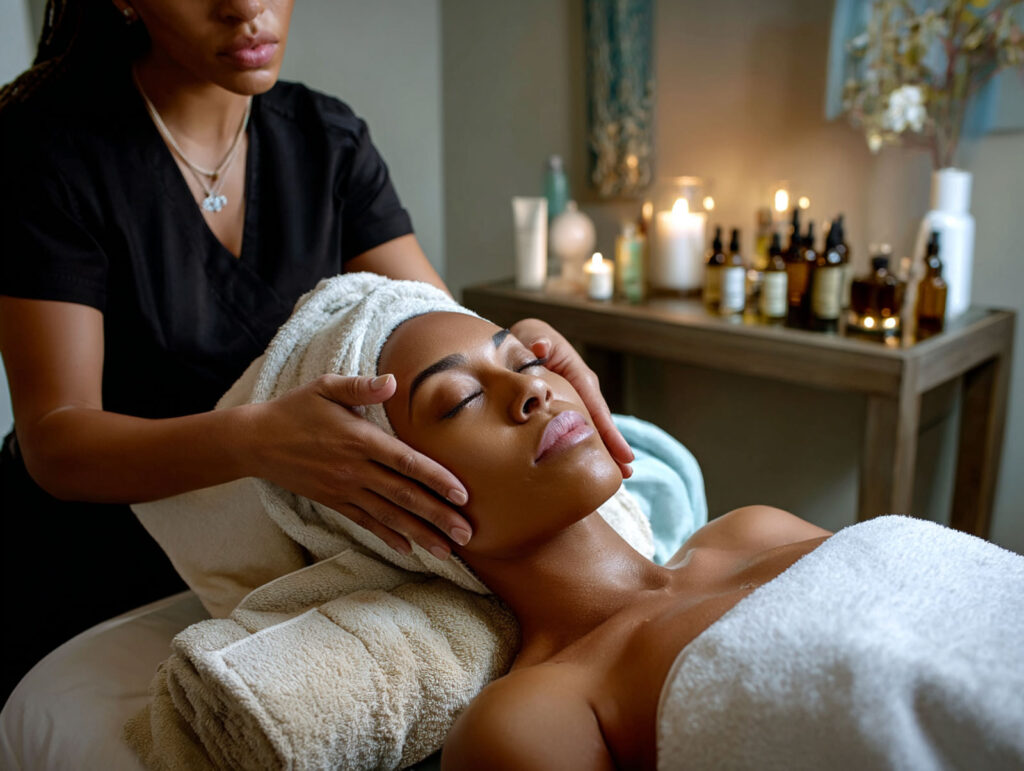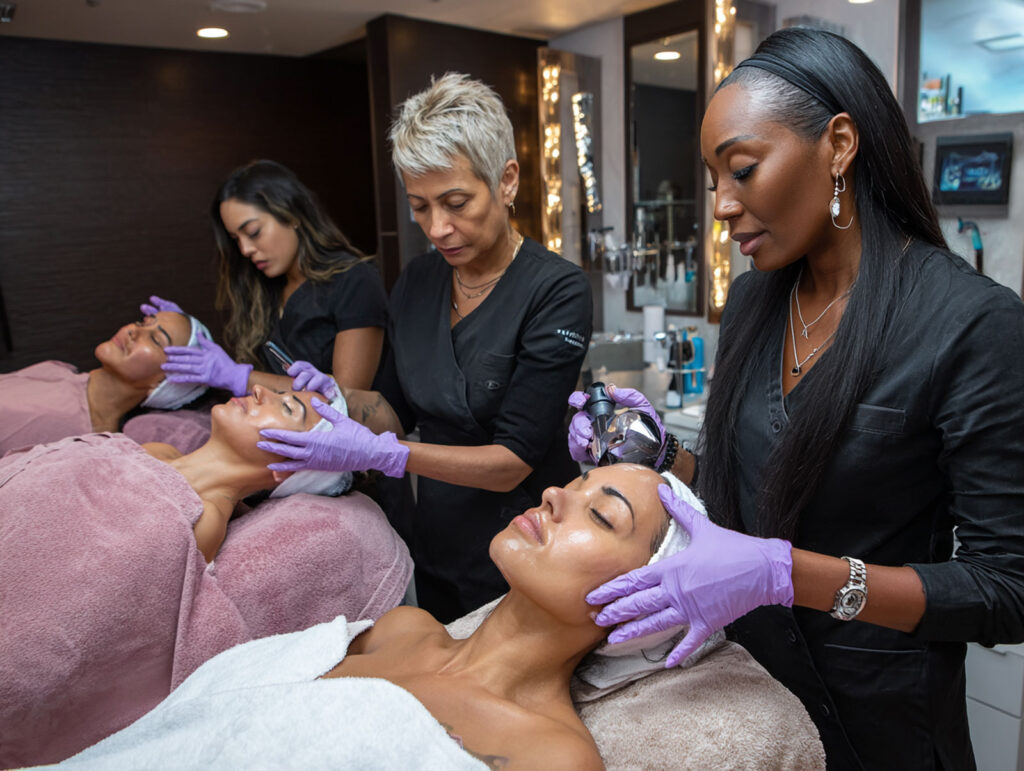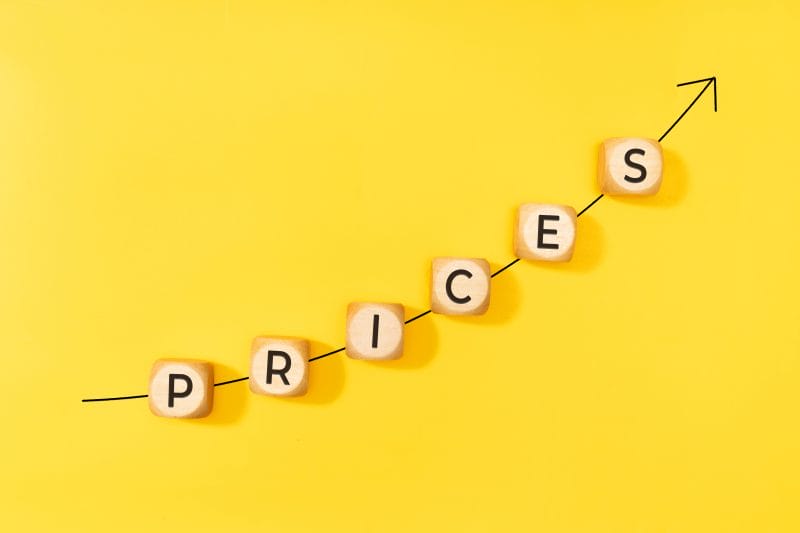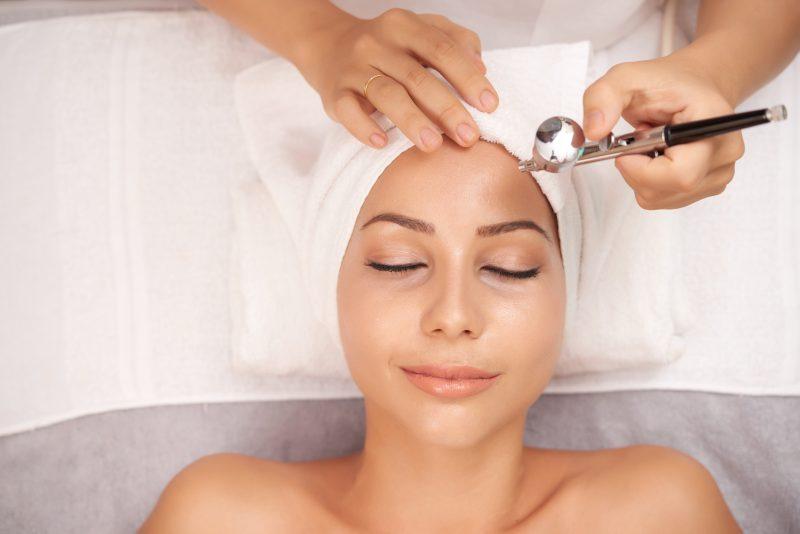Estheticians, Professional Skincare, Skincare
Why Bother with Professional Facials? The Benefits of Regular Treatments
“Skin is a beautiful thing – wear it well.” I remember hearing that at my first esthetician training, and it stuck. Because here’s the truth: while great skincare starts at home, it’s professional care that takes your results from “fine” to “wow.” In an age where high-performance serums and TikTok DIYs crowd the conversation, professional facials remain one of the most effective (and underrated) tools for maintaining truly healthy, glowing skin.
According to the American Academy of Dermatology, over 50 million Americans struggle with acne annually, while countless others face issues like dehydration, premature aging, and sensitivity. And yet, most of us only think to see a professional when something goes wrong. The real game-changer? Making facials a regular part of your routine – not just a reactive splurge.
So, let’s break it down. Why are facials more than just a pampering experience? What do they actually do for your skin? And why should “every four to six weeks” be your new skincare mantra?
What Really Happens During a Professional Facial?
Think of a facial as a reset button for your skin. While the details vary by provider and skin type, most professional facials follow a multi-step process designed to deeply cleanse, exfoliate, treat, and nourish your skin far beyond what your bathroom counter allows.
The process usually includes:
- Double cleansing to remove all traces of makeup, sunscreen, and debris
- Skin analysis to identify concerns like dehydration, congestion, or sensitivity
- Exfoliation using enzymes, acids, or microdermabrasion for smoother texture
- Extractions to safely remove blackheads and whiteheads
- Targeted masks, serums, and massage tailored to your skin’s condition
- Finishing steps like SPF and moisture sealing
This isn’t just about luxury – it’s about precision. Licensed estheticians use professional-grade products and tools you can’t access at home. More importantly, they’re trained to interpret what your skin is really saying and how to support it over time.
Why Can’t Home Skincare Do It All?
We all want to believe in miracle products. And to be fair, a solid at-home routine is crucial. But your bathroom shelf can only do so much – especially when your skin’s barrier is compromised, or you’re using the wrong formulas without knowing it. Facials go deeper. Literally.
While your favorite toner might remove surface grime, a facial can reach the deeper layers of skin where chronic issues like congestion or dehydration begin. Plus, treatments like LED therapy, ultrasonic infusion, or advanced exfoliation (think chemical peels or dermaplaning) can’t be duplicated safely or effectively at home.
Even better? The diagnostic aspect. Your esthetician can flag changes in your skin that might be related to stress, hormones, or environmental shifts – things you might overlook until they become visible problems.

How Often Should You Get a Facial for Real Results?
This is the million-dollar question. And while it’s tempting to book once before a big event and call it a day, the real benefits come from consistency.
Most pros recommend a facial every four to six weeks. Why? Because that’s the average length of a full skin cell turnover cycle. In other words, every month your skin renews itself – and a professional treatment at the end of each cycle ensures your new skin starts strong, clear, and balanced.
If you’re managing a specific concern like acne, hyperpigmentation, or signs of aging, your esthetician may suggest a more frequent schedule temporarily to get faster results. On the flip side, maintenance facials every 6–8 weeks can suffice if your skin is already in great shape and you’re using solid home care.
Can Facials Help with Acne, Redness, or Wrinkles?
Yes – and that’s one of the biggest reasons facials go beyond “pampering” and into essential care territory.
For acne, regular facials can reduce inflammation, clear pores, and speed healing through extractions, high-frequency treatment, and calming masks. They also minimize the risk of scarring by removing blockages before they stretch or damage the skin.
Redness and rosacea benefit from gentle exfoliation, barrier-strengthening serums, and lymphatic massage to improve circulation. Meanwhile, facials for aging skin focus on collagen stimulation, hydration, and elasticity through modalities like LED light or enzyme masks.
In each case, the goal isn’t just surface improvement – it’s long-term skin health. When done consistently, professional treatments support your skin’s natural repair processes and reduce reliance on heavy corrective products.
What Are the Psychological Benefits of Facials?
There’s a reason you leave the spa glowing – and it’s not just the hyaluronic acid. Skin and stress are inextricably linked. Cortisol, the stress hormone, triggers inflammation and oil production, worsens acne, and accelerates aging. Taking even an hour to unwind under the hands of a trained esthetician can regulate your nervous system, improve your breathing, and reset your emotional baseline.
A 2020 study published in Psychology, Health & Medicine found that just 45 minutes of facial massage significantly reduced self-reported stress and increased feelings of relaxation and well-being. So that “post-facial glow” is more than skin-deep – it’s a result of nervous system regulation and a decrease in inflammation. In a time when burnout is everywhere, this kind of structured self-care matters.
Do Professional Facials Cost Too Much for Regular Visits?
Let’s be honest: professional facials aren’t cheap. A standard facial ranges from $75 to $200+ depending on location and services included. But rather than seeing them as a splurge, consider them an investment in prevention.
Consistent facials can reduce your need for expensive corrective treatments later. That’s fewer emergency derm visits, fewer wasted dollars on the wrong products, and less money spent trying to reverse preventable damage.
Many estheticians offer memberships or packages that reduce the per-session cost significantly. And if budget is a concern, you can alternate between shorter express treatments and full facials to maintain results.
Also worth noting: a facial from a licensed esthetician often includes skin education. That means smarter home routines, less guesswork, and more confidence in your skin choices – another form of long-term savings.

What’s the Best Age to Start Getting Facials?
It’s never too early – or too late. Teens struggling with hormonal acne often benefit from customized acne facials that support rather than strip their skin. Adults in their 20s and 30s can use regular treatments to delay signs of aging and manage urban skin stressors like pollution. And mature skin in its 40s, 50s, and beyond thrives with professional-grade hydration, brightening, and collagen support.
What matters more than age is timing and consistency. Skin changes with the seasons, hormones, and stress levels. Having a trained professional in your corner who understands your skin’s patterns means you’re not constantly starting over when issues arise.
Can You Combine Facials with Other Skin Treatments?
Absolutely – and in fact, pairing facials with other services can maximize your results.
Many clients combine monthly facials with periodic microneedling, laser treatments, chemical peels, or cosmetic injectables. Your esthetician can prep your skin before those treatments to minimize downtime and enhance effectiveness, or help with post-treatment recovery through soothing, barrier-repairing facials.
Just make sure you’re working with licensed professionals who communicate with each other (or with you) about timing, skin sensitivity, and contraindications.
Facials don’t replace medical dermatology or more intensive procedures – but they do complement them beautifully, creating a foundation of healthy, responsive skin.
Are All Facials the Same?
Not even close. Just as your skin is unique, so are the techniques, philosophies, and product lines behind different facials. Some spas focus on clean beauty with plant-based ingredients, while others lean into science-backed formulations with actives like peptides and retinoids.
Facials can be tailored to every skin type and concern, including:
- Oxygen facials for dull or tired skin
- Enzyme facials for sensitive or reactive skin
- Deep-cleansing facials for oily or acne-prone skin
- Anti-aging facials with massage, collagen support, and LED therapy
- Hydrating facials for dry or barrier-damaged skin
The key is communication. Tell your esthetician what you’re noticing, what products you’re using, and how your skin feels – not just how it looks. The more info they have, the better they can customize your treatment.
FAQs
Is it safe to get a facial with sensitive skin or rosacea?
Yes, but you’ll need a professional experienced in gentle treatments. Look for calming facials using ingredients like aloe vera, oat extract, or niacinamide. Avoid aggressive peels or manual exfoliation unless specifically designed for your skin type.
Can I get a facial if I have active acne or breakouts?
Yes. Acne facials are designed to calm inflammation, clear blocked pores, and support skin healing. Be sure your provider knows your acne history and is trained in safe extraction practices.
How soon will I see results from a facial?
Many people notice an immediate glow, smoother texture, and softer skin. For chronic concerns like acne or discoloration, multiple sessions may be needed for visible, lasting improvements.
What should I avoid after a facial?
Skip heavy makeup, exfoliants, sun exposure, or intense workouts for 24–48 hours post-treatment. Your skin is more absorbent and sensitive after a facial – treat it gently.
Are extractions painful?
They can be a little uncomfortable but shouldn’t hurt. A skilled esthetician will prep your skin properly and use techniques that minimize trauma.
Can I use retinol before a facial?
Avoid retinoids, AHAs, or harsh exfoliants for 2–3 days before and after your facial unless your esthetician instructs otherwise.
So, Do Facials Really Matter Long-Term?
Without question. Professional facials aren’t a shortcut or indulgence – they’re a strategic tool in caring for your skin in a deeper, more responsive way. They fill in the gaps your home routine can’t, tackle stubborn concerns with skill and nuance, and offer a kind of reset that’s both physical and emotional.
Skin changes. It reacts to life. And while your serum collection might be impressive, there’s no replacement for having a professional monitor your skin’s rhythm and recalibrate it when needed.
So, if you’ve been waiting for a sign to schedule your first (or next) facial – this is it. And if anyone asks, just tell them: “My skin has a therapist.”





